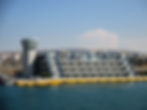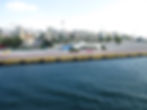Piraeus Port Buildings
- Alexandros Vrailas
- Aug 22, 2015
- 6 min read
Updated: Jul 1
Piraeus, the main port of Greece's capital city, Athens, is, by far, the most diverse and exciting port in the world for any shipping enthusiast like myself. It has been active for more than 2800 years, and is today the center of Greek shipping. It is the largest port on the Eastern Mediterranean Sea, the largest port in Greece and the largest passenger port in Europe. The entire port spreads from Glyfada to the vicinity neighborhoods of Drapetsona, Keratsini and Perama, up until the Gulf of Salamina and the Elefsina Bay.
Today, the passenger area of the port can fit more than 40 ships of different types. It is the gateway to the Aegean Sea and more specifically to the Cyclades, the Dodecanese, Crete, the Northeast Aegean Sea Islands, the region of Macedonia, the Sporades and the Saronic Gulf, and also other countries on the Mediterranean Sea. For most tourists and people visiting the islands, their journey starts from Piraeus. Everyday, ferries, high speed craft and cruise ships come and go to transport passengers to and from the islands from the entire Aegean Sea. Apart from the port's ferry terminals, Piraeus also has many buildings that highlight Greece's shipping activities. Many Greek shipping companies have their office buildings there, as do many tourist and travel agencies and marketing companies. The photos below give the overall image of Piraeus' busy everyday life, and show a part of the heart of Greek shipping.
Piraeus has 12 gates of departures, all managed by its Port Authority:
E1: Dodecanese
E2: Northeast Aegean Sea
E3: Crete and Kythira entrance
E4: Kythira exit
E5: Bus terminals and pedestrians' entrance
E6: Cyclades
E7: Cyclades
E8: Saronic Gulf
E9: Cyclades and Northeast Aegean Sea
E10: Cyclades and Northeast Aegean Sea
E11: Cruise Terminal A
E12: Cruise Terminal B

One of the most recognisable buildings in Piraeus: the headquarters of the Ministry of Shipping and Insular Policy, located right next to Gate E1. The building was completed in 2007, and also features the port's control tower.

The Ministry Building seen from the opposite side of the port.

The Ministry Building and a part of the control tower.

Right next to the Ministry's headquarters, we can find the main port's two drydocks: the Main Vassiliadis Drydock and the Small Vassiliadis Drydock. The first one can fit regular conventional ferries and yachts, while the second one can fit small ferries, landing craft, double-ended ferries, tugs and other traditional boats. On the small drydock is the double-ended ferry ATHINA P of Athinais Lines, which operates on the Perama-Salamina line.

The drydock is seen in the background of this picture. Next to it is the floating museum HELLAS LIBERTY, a former Liberty ship. She is one of the only three surviving members of her class, which operated for the United States during World War II. The class had 2710 ships. This one was donated to Greece by the United States in 2008 and she opened as a museum in 2010.

The Main Vassiliadis Drydock. In this picture it refits the FAST FERRIES ANDROS, Fast Ferries' most recent acquisition, one month before she began her service from Rafina to the Cyclades. She spent her service on the Rafina-Syros-Tinos-Mykonos line during the summer of 2015, and is now on the company's main line: the Rafina-Andros-Tinos-Mykonos line.

Next to the drydocks are the former Piraeus Shipyards, which have been abandoned since the main port became a full-time passenger port. The shipyards are now located in Drapetsona, Perama and Keratsini, all of which are part of the Piraeus Vicinity. However, the buildings are now decorated with advertisements related to the port, shipping companies or Greek culture. This building shows the Port Authority's advertisement for 2021, which will be one of the most important years in the history of Piraeus. It will mark the 2500th anniversary of the legendary battle of Salamina, the 200 years of Greek independence, and for this year Piraeus and Salamina are candidate cities in order to serve as the Cultural Capital Cities for the European Union.

Next is this former shipyard which features an amazing graffiti work design showing the sculpture from 'The Victory of Samothraki'. The clock at the top still works today.

Then comes another advertisement made by the Port Authority for 2021. It shows the planned construction of the Cultural Coast of Piraeus, which will be located in the same spot as the currently-abandoned shipyards. The new facilities will promote the city's status as Cultural Capital City for the European Union. The construction of this coast will normally begin in 2017.

This is the Cruise Terminal A of the port, also known as Miaoulis. It can fit 4 medium-sized cruise ships at one time.

A view of Cruise Terminal A, which can also fit small cruise ships and sailing ships. In this picture you can see the small cruise ship ARTEMIS of Grand Circle Travel, the Mexican training ship CUAUHTÉMOC, a tug boat and the bow of the CELESTYAL OLYMPIA of Celestyal Cruises.

A very famous landmark of the port: the Piraeus Lion sculpture. It is a copy of the original sculpture, which is said to have been present in Piraeus since the 1st century. It remained there until 1687, when it was controversially stolen by the Venetians who occupied Athens during that time. It remains in Venice, and is displayed at the Venetian Arsenal.

This building, located outside of the E6 Gate, is the Piraeus Port Authority's headquarters. The Port Authority, also known as OLP ('ΟΛΠ' in Greek) is the current owner and manager of the entire port. The overpass in front of the building, which looks like a sailing ship, connects the port with the electrical railway station of Piraeus (Line 1 of the Athens Metro). It was built by Santiago Calatrava for the 2004 Summer Olympics which were held in Athens.

This picture shows the Cyclades ferry ticket agencies seen in the front, featuring Blue Star Ferries' ticket-selling kiosks. In the background are the current and former ANEK Lines offices. The company has moved to the tall light blue building since 2014, leaving the dark blue and yellow building on the right deserted.

The Hellenic Seaways headquarters, which are located in a beautiful Neoclassical six-story building right between the E7 gate and the E8 gate. The side part of the building is known for displaying advertisements promoting Hellenic Seaways. That year, the advertisement sign featured the company's logo and two of its most important ships: the cruiseferry NISSOS MYKONOS (built in 2005) and the high speed ferry HIGHSPEED 4 (built in 2000).

The kiosk of Zante Ferries, which is located right next to the E9 gate, where its ferries operating from Piraeus depart. Founded in 1991, the company was based on the Ionian Sea, primarily on the Kyllini-Zakynthos line, until it began an expansion on the Cyclades in 2008, with the acquisition of the ferry ADAMANTIOS KORAIS. The success of the latter on the Western Cyclades led to the company bringing another ship previously based on the Ionian Sea to the region: the ANDREAS KALVOS. Therefore, in 2015, two Zante Ferries ships operated on the Western Cyclades, while only one (the DIONISIOS SOLOMOS) operated on the Ionian Sea. The three ships' names are mentioned right next to the company's name, as are the islands served by the ships operating on the Aegean Sea. These are Kythnos, Serifos, Sifnos, Milos, Kimolos, Folegandros, Sikinos, Ios and Santorini, which form the Western Cyclades lifeline which has been served efficiently by the company.

The kiosk of Minoan Lines, located next to the E3 gate. It is used by passengers traveling with the two ferries that operate for the company on the Aegean Sea. These are the KNOSSOS PALACE and the FESTOS PALACE, which connect Piraeus with Crete through the Piraeus-Heraklion line. The company's name, logo, website and destinations (including their service on the Adriatic Sea) are mentioned at the top of the kiosk.

The former Hellenic Seaways and GA Ferries office building. The first company moved right down the street in 2007, while the second one has been defunct since 2009. It is there that Minoan Flying Dolphins (Hellas Flying Dolphins and Hellenic Seaways' predecessor) executive Pantelis Sfinias committed suicide on 29 November 2000, two months after his company's ship, the EXPRESS SAMINA, had sunk in Paros. Sfinias had been under pressure from the Greek Court and the Hellenic Coast Guard for apparently not respecting the safety measures on his ships. Unable to handle the increasing pressure from the media and the impending legal actions taken against him, he jumped from the sixth floor of this building.
Lastly, the port is decorated with many advertising signs made by coastal service companies. Here are two notable signs that I found:

The new advertisement sign of Hellenic Seaways for 2015, namely the new NISSOS RODOS itineraries following the ship's return to the Aegean Sea, for service to, Syros, Mykonos, Patmos, Ikaria and Samos, as shown by the sign. The ship also made stops in Chios, Mytilene, Limnos and Kavala.

A sign from a tourist agency building which is very interesting. It was installed in the mid-1990s, as suggested by the companies which are advertised. Today, DANE Sea Line, GA Ferries, Agapitos Lines, Agapitos Express Ferries and the Cyclades Joint Venture are all defunct, and they are soon very likely to be joined by NEL Lines. Only Minoan Lines, ANEK Lines and LANE Sea Lines continue to operate.
There are no doubts about this: Piraeus is a great port, with excellent organisation and with huge daily contribution the Greek maritime industry. It will surely improve even more in the future, and all eyes will be on it in 2021, where it will reveal its importance to history, culture and globalisation.
